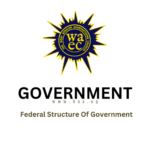THEORY
1. (a) What is a confederation?
(b) Highlight the problems that are likely to arise in a confederal state.
2. Outline five features of a confederal system of government.
OBJECTIVES
1. In a confederation, more powers reside in the
A. component units.
B. president.
C. central government.
D. prime minister.
2. Which of the following is a disadvantage of confederation?
A. The central government is too far from the people.
B. the central authority is vested with too much power.
C. The primary loyalty of the citizens is to the central government.
D. It encourages secession.
3. An advantage of a confederation over a federation is that the component units
A. have the right to secede.
B. Share resources equally.
C. are politically stable.
D. co-operate fully with the centre.
4. Confederalism was once practiced in
A. Nigeria and Ghana.
B. Senegal and The Gambia.
C. Mali and Cote d’Ivoire.
D. Ghana and Benin.
5. Which of the following is a feature of a confederation?
A. It has a rigid constitution.
B. The central government is stronger than the component units.
C. There is a legal right of secession.
D. There is no provision for a state constitution.
6. Autonomy of constituent units is an important feature of
A. confederal government.
B. presidential government.
C. unitary government.
D. parliamentary government.
7. In a confederation, each of the component states is
A. militarily weak.
B. under populated.
C. virtually sovereign.
D. underdeveloped.
8. Which of the following countries had practiced confederal system of government?
A. Senegal and Gambia.
B. Mali and Senegal.
C. Ghana and Sierra Leone.
D. Nigeria and Niger.
9. A system of government where the component units are stronger than the central authority is known
as
A. federalism.
B. confederation.
C. fascism.
D. feudalism.
10. The practice of two or more sovereign states uniting for security and external affairs is called
A. totalitarianism.
B. confederalism.
C. republicanism.
D. sectionalism.
11. Primary loyalty of a citizen in a confederal state goes to the
A. government at the centre.
B. confederating units.
C. the sovereign state.
D. assembly at the centre.
12. Confederal system of government means
A. powerful revenue for component governments.
B. The central and component governments have equal powers.
C. The central government legislates for the component governments.
D. The central government is weaker than the component governments.
13. Which of the following is not a characteristic of confederation?
A. The right to secede is allowed.
B. Sovereignty resides in the centre.
C. The centre and units agree before taking decisions.
D. Autonomous units are more powerful than the centre.
14. Which of the following factors usually leads to the collapse of a confederal state
A. Weak central government.
B. Absence of a confederal parliament.
C. Ill-equipped armed forces.
D. Absence of a ceremonial Head of State.
15. The confederal system of government is unpopular because
A. the government operates oligarchy system.
B. it does not follow due process.
C. it discourages rapid development.
D. all the component units are sovereign
16. A feature of a confederal state is that
A. it is a single sovereign state.
B. its constitution is flexible.
C. any unit can secede at will.
D. its powers are distributed equally between the centre and units.
17. In which of the system of government are all the component units sovereign?
A. Confederal
B. Federal
C. Monarchical
D. Republican.



